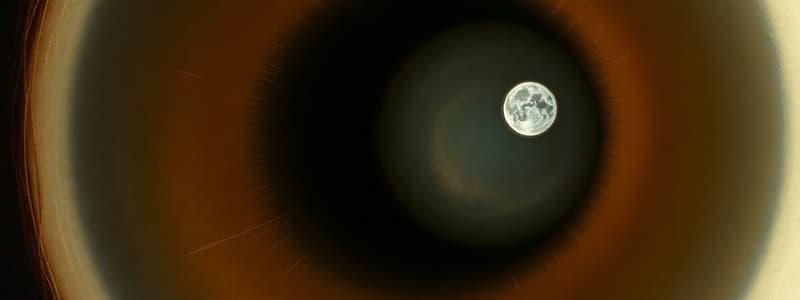Podcast
Questions and Answers
The optic vesicle induces changes in the surface ectoderm necessary for cornea formation.
The optic vesicle induces changes in the surface ectoderm necessary for cornea formation.
False (B)
The hyaloid artery reaches the inner chamber of the eye through the choroid fissure.
The hyaloid artery reaches the inner chamber of the eye through the choroid fissure.
True (A)
The inner layer of the optic cup develops into the pigmented layer of the retina.
The inner layer of the optic cup develops into the pigmented layer of the retina.
False (B)
Rods are photoreceptors mainly responsible for color vision and are less sensitive to light compared to cones.
Rods are photoreceptors mainly responsible for color vision and are less sensitive to light compared to cones.
The pars ceca retinae forms the inner layer of the iris and participates in the formation of the ciliary body.
The pars ceca retinae forms the inner layer of the iris and participates in the formation of the ciliary body.
The sphincter and dilator pupillae muscles develop from the mesenchyme external to the optic cup.
The sphincter and dilator pupillae muscles develop from the mesenchyme external to the optic cup.
New lens fibers are continuously added to stop the growth of the lens by the end of the seventh week.
New lens fibers are continuously added to stop the growth of the lens by the end of the seventh week.
The sclera is derived from the outer mesenchymal layer surrounding the eye primordium.
The sclera is derived from the outer mesenchymal layer surrounding the eye primordium.
The iridopupillary membrane is essential for proper lens formation and is maintained throughout adult life.
The iridopupillary membrane is essential for proper lens formation and is maintained throughout adult life.
The aqueous humor is produced by the corneal endothelium and nourishes the retina.
The aqueous humor is produced by the corneal endothelium and nourishes the retina.
The vitreous body is formed from the neural crest cells that invade the optic cup.
The vitreous body is formed from the neural crest cells that invade the optic cup.
The optic nerve develops from the outer wall of the optic stalk.
The optic nerve develops from the outer wall of the optic stalk.
Loss of midline tissue in early gestation can lead to a spectrum of defects including cyclopia and synophthalmia.
Loss of midline tissue in early gestation can lead to a spectrum of defects including cyclopia and synophthalmia.
The central artery of the retina is derived from the distal portion of the hyaloid artery.
The central artery of the retina is derived from the distal portion of the hyaloid artery.
Coloboma results if the choroid fissure fails to close completely during the seventh week, leading to a cleft in various eye structures.
Coloboma results if the choroid fissure fails to close completely during the seventh week, leading to a cleft in various eye structures.
PAX6, initially expressed in a band in the dorsal neural ridge, is the key regulatory gene for neural tube formation, not directly eye development.
PAX6, initially expressed in a band in the dorsal neural ridge, is the key regulatory gene for neural tube formation, not directly eye development.
SONIC HEDGEHOG (SHH) promotes PAX6 expression in the center of the eye field.
SONIC HEDGEHOG (SHH) promotes PAX6 expression in the center of the eye field.
Fibroblast growth factors (FGFs) from the mesenchyme promote differentiation of the pigmented (outer layer) of the retina.
Fibroblast growth factors (FGFs) from the mesenchyme promote differentiation of the pigmented (outer layer) of the retina.
Transforming growth factor b (TGF-b), secreted by the overlying surface ectoderm, promotes the differentiation of the neural retina (inner layer).
Transforming growth factor b (TGF-b), secreted by the overlying surface ectoderm, promotes the differentiation of the neural retina (inner layer).
Lens crystallin formation is initiated by the combined expression of PAX6, SOX2, and LMAF, but SIX3 inhibits crystallin gene expression.
Lens crystallin formation is initiated by the combined expression of PAX6, SOX2, and LMAF, but SIX3 inhibits crystallin gene expression.
Flashcards
Optic Vesicles
Optic Vesicles
Outpocketings of the forebrain that induce lens formation.
Optic Cup
Optic Cup
Double-walled structure formed by the invagination of the optic vesicle.
Choroid Fissure
Choroid Fissure
Transient opening on the inferior surface of the optic cup for the hyaloid artery.
Lens Placode
Lens Placode
Signup and view all the flashcards
Lens Vesicle
Lens Vesicle
Signup and view all the flashcards
Retinal Pigmented Layer
Retinal Pigmented Layer
Signup and view all the flashcards
Neural Layer of Retina
Neural Layer of Retina
Signup and view all the flashcards
Rods and Cones
Rods and Cones
Signup and view all the flashcards
Pars Ceca Retinae
Pars Ceca Retinae
Signup and view all the flashcards
Pars Iridica Retinae
Pars Iridica Retinae
Signup and view all the flashcards
Pars Ciliaris Retinae
Pars Ciliaris Retinae
Signup and view all the flashcards
Cornea
Cornea
Signup and view all the flashcards
Choroid
Choroid
Signup and view all the flashcards
Sclera
Sclera
Signup and view all the flashcards
Vitreous Body
Vitreous Body
Signup and view all the flashcards
Optic Nerve
Optic Nerve
Signup and view all the flashcards
PAX6
PAX6
Signup and view all the flashcards
Sonic Hedgehog (SHH)
Sonic Hedgehog (SHH)
Signup and view all the flashcards
Coloboma
Coloboma
Signup and view all the flashcards
Aphakia
Aphakia
Signup and view all the flashcards
Study Notes
Optic Cup and Lens Vesicle
- The developing eye starts as shallow grooves on the sides of the forebrain in the 22-day embryo
- These grooves become optic vesicles through outpocketings as the neural tube closes
- Optic vesicles induce changes in the surface ectoderm, essential for lens formation
- The optic vesicle invaginates, forming a double-walled optic cup
- The space between the inner and outer layers of this cup is initially known as the intraretinal space
- The intraretinal space disappears as the layers appose each other
- Invagination involves the inferior surface forming the choroid fissure
- The hyaloid artery uses the choroid fissure to access the inner eye chamber
- The choroid fissure's lips fuse during the seventh week, creating the pupil
Lens Development
- Cells of the surface ectoderm elongate to form the lens placode
- The lens placode develops into the lens vesicle through invagination
- During the fifth week, the lens vesicle separates from the surface ectoderm
- The lens vesicle lies in the mouth of the optic cup
Retina, Iris, and Ciliary Body
- The outer layer of the optic cup is the pigmented layer of the retina, characterized by pigment granules
- The inner (neural) layer of the optic cup’s posterior four-fifths is the pars optica retinae
- Cells in the pars optica retinae differentiate into photoreceptive rods (120 million) and cones (6-7 million)
- Rods are more sensitive but do not detect color, unlike cones
- Adjacent to the photoreceptive layer is the mantle layer
- The mantle layer gives rise to neurons and supporting cells that creates the outer and inner nuclear layers, and the ganglion cell layer
- A fibrous layer containing nerve cell axons lies on the surface
- Nerve fibers converge toward the optic stalk, which develops into the optic nerve
- Light impulses pass through most retinal layers before reaching the rods and cones
- The anterior fifth of the inner layer is the pars ceca retinae, which remains one cell layer thick
- Pars ceca retinae divides into the pars iridica retinae, forming the inner iris layer, and the pars ciliaris retinae, participating in ciliary body formation
Iris and Ciliary Body Formation
- Loose mesenchyme fills the space between the optic cup and surface epithelium
- The sphincter and dilator pupillae muscles form in this mesenchyme from the optic cup's ectoderm
- The adult iris is formed by the pigment-containing external layer, the unpigmented internal layer of the optic cup, and vascularized connective tissue containing pupillary muscles
- Pars ciliaris retinae has marked folding
- Mesenchyme covers the exterior and forms the ciliary muscle
- A network of elastic fibers, the suspensory ligament or zonula, connects the interior to the lens
- Ciliary muscle contraction controls lens curvature by changing tension
Lens Development Specifics
- Posterior wall cells of the lens vesicle elongate anteriorly, forming long fibers
- The primary lens fibers reach the anterior wall by the end of the seventh week
- Secondary lens fibers are continuously added to the central core, so, lens growth isn't finished at this stage
Choroid, Sclera, and Cornea
- The eye primordium is surrounded by loose mesenchyme at the end of the fifth week
- Mesenchyme differentiates into inner and outer layers
- The inner layer forms the highly vascularized pigmented choroid
- The outer layer develops into the sclera and is continuous with the dura mater around the optic nerve
- Mesenchymal layers differentiate differently on the anterior aspect of the eye
- The anterior chamber is a product of vacuolization and splits the mesenchyme into the iridopupillary membrane and the substantia propria of the cornea
- The anterior chamber is lined by flattened mesenchymal cells
- The cornea consists of:
- Epithelial layer (surface ectoderm)
- Substantia propria/stroma (continuous with the sclera)
- Epithelial layer (borders the anterior chamber)
- The iridopupillary membrane disappears
- The posterior chamber sits between the iris, lens, and ciliary body
- The anterior and posterior chambers are filled with aqueous humor, which is produced by the ciliary process of the ciliary body
- Aqueous humor travels from the posterior to the anterior chamber, providing nutrients to the avascular cornea and lens
- Aqueous humor passes through the scleral venous sinus (canal of Schlemm) at the iridocorneal angle, where it is resorbed into the bloodstream
- Blockage of flow at Schlemm's canal is a cause of glaucoma
Vitreous Body
- Mesenchyme invades the optic cup through the choroid fissure
- Mesenchyme forms the hyaloid vessels (supplying the lens) and a vascular layer on the inner retina surface
- A delicate network of fibers forms between the lens and retina
- The interstitial spaces of this network fill with a transparent gelatinous substance
- The hyaloid vessels obliterate and disappear during fetal life, leaving the hyaloid canal
Optic Nerve Formation
- The optic cup connects to the brain through the optic stalk, featuring the choroid fissure on its ventral surface
- Hyaloid vessels are in the choroid fissure
- Nerve fibers return to the brain, lying among the inner stalk wall cells
- The choroid fissure closes during the seventh week
- A narrow tunnel forms inside the optic stalk
- The inner stalk wall grows due to increasing nerve fibers
- The inner and outer stalk walls fuse
- Inner layer cells provide a network of neuroglia that supports optic nerve fibers
- The optic stalk transforms into the optic nerve
- Its center contains a portion of the hyaloid artery, later the central artery of the retina
- Pia arachnoid and dura surround the optic nerve, continuations of the choroid and sclera
Molecular Regulation
- PAX6 is the primary regulatory gene for eye development
- PAX6 is a transcription factor in the PAX (paired box) family of transcription factors
- Contains a paired domain and a paired-type homeodomain
- Initially expressed in the anterior neural ridge of the neural plate
- The single eye field separates into two optic primordia
- SONIC HEDGEHOG (SHH), expressed in the prechordal plate, signals this separation
- SHH upregulates PAX2 in the center of the eye field
- SHH downregulates PAX6
- PAX2 is expressed in the optic stalks, while PAX6 is expressed in the optic cup and overlying surface ectoderm that forms the lens
- Interactive signals regulate optic cup formation between:
- Optic vesicle
- Surrounding mesenchyme
- Overlying surface ectoderm (lens-forming region)
- Fibroblast growth factors (FGFs) from the surface ectoderm promote neural (inner layer) retina differentiation
- Transforming growth factor b (TGF-b), secreted by mesenchyme, directs formation of the pigmented (outer) retinal layer
- MITF and CHX10 are expressed, directing differentiation of the pigmented and neural layers, respectively
- Lens ectoderm is essential for proper optic cup formation
Lens Differentiation
- Differentiation depends on PAX6
- PAX6 acts in the surface ectoderm to regulate lens development
- PAX6 expression upregulates the transcription factor SOX2
- SOX2 maintains PAX6 expression in the prospective lens ectoderm
- The optic vesicle secretes BMP4
- BMP4 upregulates and maintains SOX2 expression and LMAF
- PAX6 regulates the expression of two homeobox genes, SIX3 and PROX1
- PAX6, SOX2, and LMAF initiate expression of lens crystallin formation genes, including PROX1
- SIX3 regulates crystallin production by inhibiting the crystallin gene
- PAX6, through FOX3, regulates cell proliferation in the lens
Eye Abnormalities
- Coloboma:
- Choroid fissure fails to close on time during the seventh week
- Causes a cleft
- Usually in the iris (coloboma iridis)
- May extend into the ciliary body, retina, choroid, optic nerve, or eyelids
- Is a common eye abnormality
- May be linked to mutations in PAX2
- Renal defects:
- Mutation in PAX2
- Are part of the renal coloboma syndrome
- Persistent iridopupillary membrane:
- Doesn’t resorb during formation of the anterior chamber
- Congenital cataracts:
- The lens becomes opaque during intrauterine life
- Usually genetically determined
- Associated with maternal rubella infection between the fourth and seventh weeks of pregnancy
- However, after the seventh week of pregnancy, the lens may escape damage
- May be associated with hearing loss
- Nearly eradicated in the United States due to the MMR vaccine
- Persistent hyaloid artery:
- Causes a cord or cyst
- The distal portion of this vessel degenerates, but the proximal part remains
- Should be only the central artery of the retina
- Microphthalmia:
- The eye is too small (two-thirds of normal volume)
- Results from intrauterine infections (cytomegalovirus and toxoplasmosis)
- Anophthalmia:
- Absence of the eye
- Accompanied by severe cranial abnormalities
- Congenital aphakia:
- Absence of the lens
- Aniridia:
- Absence of the iris
- Mutations in PAX6
- Rare anomalies that result from disturbances in induction and development of tissues responsible for formation of these structures
- Cyclopia and synophthalmia:
- Eyes are partially or completely fused
- Defect caused by loss of midline tissue
- Occurs as early as days 19 to 21 of gestation
- Underdevelopment of the forebrain and frontonasal prominence
- Associated with holoprosencephaly
- Is caused by:
- Maternal alcohol use
- Maternal diabetes
- Mutations in SHH
- Abnormalities in cholesterol metabolism disrupting SHH signaling
Studying That Suits You
Use AI to generate personalized quizzes and flashcards to suit your learning preferences.



